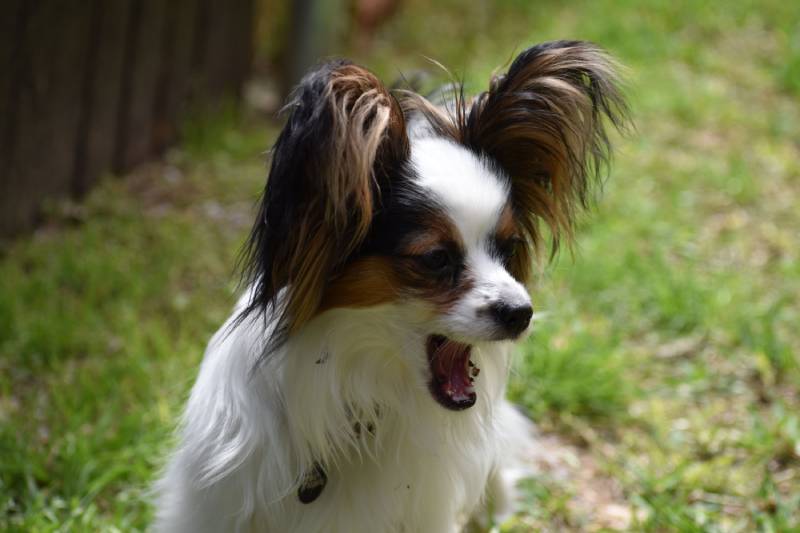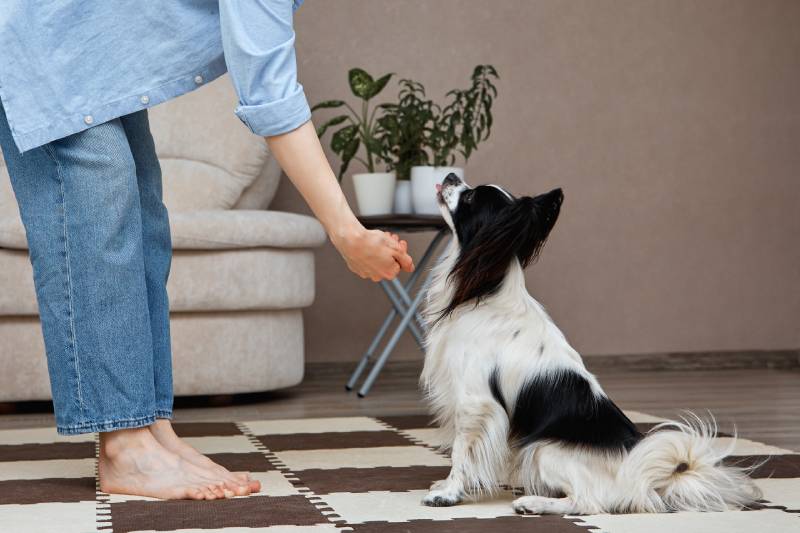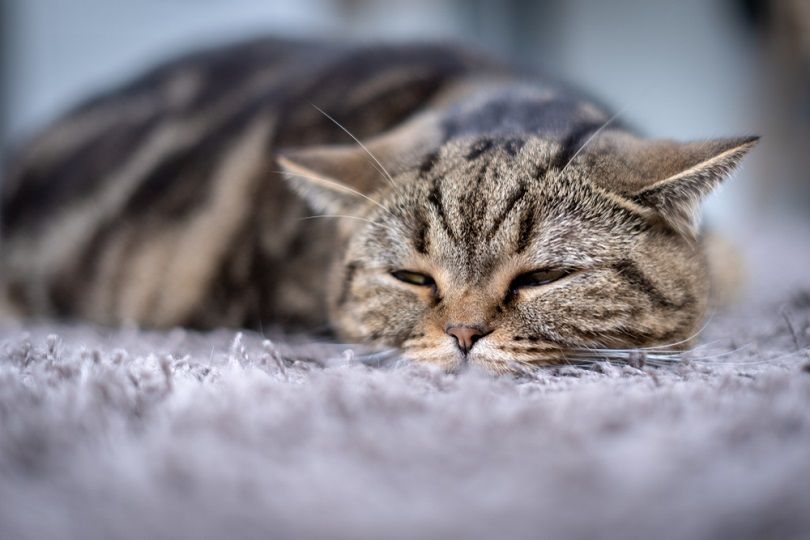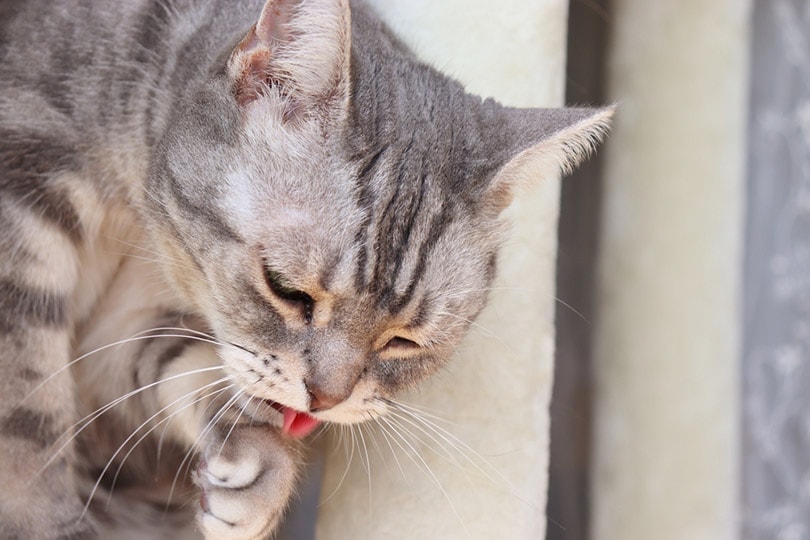5 Common Papillon Health Issues: Our Vet Explains What To Do
By Dr. Kim Podlecki, DVM (Vet)
Updated on

The Papillon is typically a happy, spunky little dog, full of energy and love. The name Papillon is French and means “butterfly-eared”. This is because Papillons are known for their pointy, wing-like ears that are covered in flowing long hair. While this hair is the hallmark of the Papillon, it can sometimes create problems. While the Papillon is generally a healthy dog, there are some other health conditions to be aware of. Continue reading to learn more about what Papillon health issues you should watch out for.
The 5 Common Papillon Health Issues
1. Collapsing Trachea
The trachea is otherwise known as the windpipe. It’s the connection from the back of the throat, all the way to the lungs, carrying air to and from the chest. The trachea is composed of cartilage rings that hold the windpipe open and help maintain its tube-like shape. In some dogs, they may be born with a trachea that is narrower than normal, known as a hypoplastic trachea. In other dogs, the cartilage rings that hold the trachea open will weaken and the trachea will collapse on itself. When this happens, this will narrow the diameter of the windpipe, making it much more difficult to move air to and from the lungs.
Papillons, as with many small breed dogs, are much more prone to this disease than in medium to larger sized dogs. The collapsing of the trachea can trigger coughing, which is made worse in the hot weather and/or after exercise. Sometimes just a small portion of the trachea is affected, while other times almost the entire length of the trachea can collapse. This condition usually worsens with age.
The more a Papillon coughs and/or tries to breathe, the more inflammation that occurs, and the worse the condition will get. Some Papillons will need to be on medications to help manage inflammation and/or coughing, especially in the summer months. Other times your Papillon may need to have a stent placed to help hold the windpipe open. This is a very specialized procedure and is not done on a routine basis. Your veterinarian can perform diagnostics to help determine how severe your Papillon’s collapsing trachea is and best dictate treatment options.

2. Dental Disease
Dental disease is prominent in any sized dog, but especially the toy breed dogs such as the Papillon. If your Papillon also has an underbite or an overbite, this may make them more prone to getting severe dental tartar as your dog ages. However, even younger toy breed dogs can get severe dental tartar.
You may notice your Papillon has bad breath, known as halitosis. There may be redness to the gums, especially along the gumline of the teeth. Tartar can build up on any of the teeth. Sometimes the tartar becomes so severe that your Papillon’s teeth will fall out on their own. You may notice your dog dropping kibble as they eat, pawing at their face, or tilting their head while they chew. All of these may be signs of significant dental disease.
Dental disease can be prevented, or at least controlled, with regular teeth brushing, veterinary-approved dental chews, and even prescription dental food. Most veterinarians will never recommend giving your Papillon rawhides, cow ears, bones, or other chews for teeth cleaning. These often cause more trauma by breaking the teeth, or even becoming stuck, causing your pup to choke. We recommend speaking to your veterinarian about their recommendations for toothpaste, appropriate chews, and/or food.
Regular dental cleanings are always recommended for toy breed dogs, especially if your Papillon will not allow you to brush their teeth. Remember, regular dental cleaning for the entire life of your Papillon is much more effective than just cleaning them once tartar starts to build up.
3. Matted Hair
It’s not a secret that Papillons have long, flowing hair. This is what makes them unique! But with that hair comes a lot of responsibility on the part of the pup parent. Your Papillon will need regular brushing and regular grooming. Depending on how long your dog’s hair is, where you live, and what their environment is like, your Papillon may need to be groomed every few weeks. At minimum, your Papillon will need to be brushed regularly.
When the long hair of a dog or cat is not brushed, the hair can start to get twisted and matted. In addition, leaves, twigs and other debris can become stuck in the fur as well. The more matted the hair becomes, it will actually pull on the skin, causing significant pain. Once matting occurs, it typically cannot be brushed out and needs to be clipped.
It’s always recommended to use a professional groomer for any type of grooming and clipping, but especially with severe matting. Oftentimes owners will try to clip their Papillon at home and accidentally cut their dog. Getting regular grooming for your Papillon at a young age will get them used to being handled, brushed, trimmed, and clipped. Regular grooming will also help to prevent any matting and pain.

4. Luxating Patella(s)
The patella is another name for the kneecap. The Papillon has two patellas, as do all dogs, that normally sit in the middle of the knee on either back leg. The patella assists with bending and straightening of the stifle (knee) joint. A luxating patella is when one or both kneecaps move to either the inside, or the outside of the stifle. In small breed dogs such as the Papillon, luxating patellas are often hereditary. The movement, or luxation, of the kneecap occurs from the groove that holds the patella in place being too shallow to hold it in the center. This will then cause the kneecap to float to either side of the knee and not stay in the center.
Papillons may have one or two luxating patellas. These can sometimes be painful. The kneecap may become stuck to one side of the knee which is painful in itself. However, if it becomes stuck, your dog is then unable to straighten and/or bend the knee like normal. Even if the patella does not become stuck, with time arthritis will develop in the knee joint from the constant abnormal movement of the patella. This will sometimes cause ligament injuries as well.
Your veterinarian will likely recommend lifelong joint supplements and weight management for your Papillon if they have luxating patella. If it is severe and/or if arthritis is present, anti-inflammatories and pain medications are often added. Some Papillons will need surgery if the condition is uncomfortable enough.
5. Behavioral Problems
Any dog can become protective of their family. Protection is not inherently bad. However, when the family dog won’t allow anyone else near them or the family, and/or becomes aggressive and attacks, then it’s a problem. Because Papillons are small, even when fully grown, owners will often carry them around and constantly pick them up from a young age. This can often cause dogs to be reactive and even aggressive to others when they are around their owners, especially if they are in their owner’s arms.
Dogs that are constantly picked up, held, and/or allowed to act like this can be difficult patients to handle at the veterinarian or the groomer. They will become distrustful of strangers and often can develop significant anxiety. These smaller dogs will sometimes become territorial with their families even in the house. Therefore, when other family, friends, or children are around, they may attack unprovoked if they feel threatened.
As with any dog, always work on training from the time you get them. It’s never too early to start training your dog with treats, toys, or other positive rewards to get them to listen to basic commands. Taking your dog for walks on a leash and not constantly holding them may help with long-term anxiety and aggression issues.

Conclusion
The Papillon is known for being an overall healthy, happy, energetic small breed dog. They can be great companions for a lot of people. Although they are generally very healthy, Papillons can suffer from health problems. A collapsing trachea and luxating patella(s) can be problems that a Papillon is born with. Health problems such as dental disease, matted hair, and often behavioral issues are also often seen with Papillons. Working with your pup from a young age to have them groomed, have their teeth brushed, and working on training can hopefully help to prevent serious problems as your dog ages.
Featured Image Credit: Di Studio, Shutterstock













